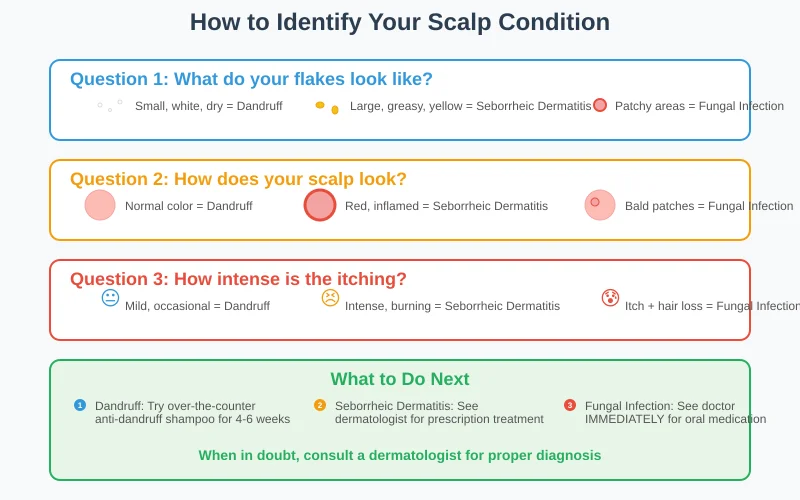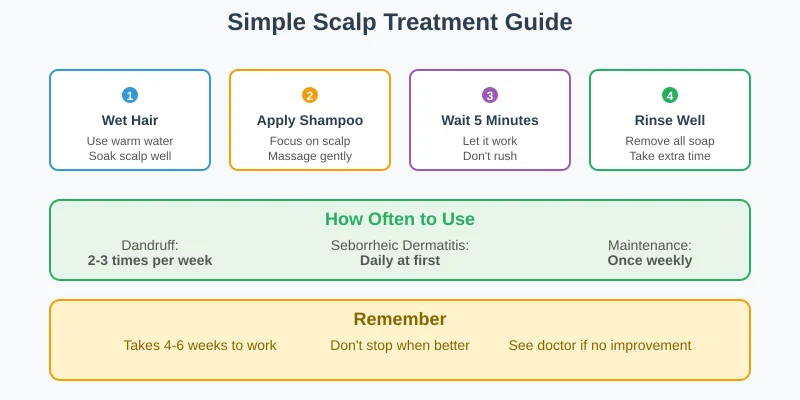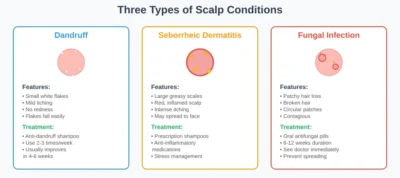Itchy Scalp: Dandruff, Dermatitis, or Fungal Infection?
Picture this: You’re sitting in an important meeting when that familiar tingling sensation starts on your scalp. The urge to scratch becomes overwhelming, and you notice small white flakes falling onto your dark shirt. Sound familiar? You’re not alone – millions of people worldwide struggle with itchy scalp conditions that can be both uncomfortable and embarrassing.
The problem is that most people assume they have “dandruff” and grab the first anti-dandruff shampoo they see. But here’s what many don’t realize: there are actually three different conditions that can cause an itchy, flaky scalp, and each one needs a completely different treatment approach. Using the wrong treatment can actually make your condition worse.
In Pakistan’s hot, dusty climate, scalp problems are incredibly common. The combination of heat, humidity during monsoons, frequent dust exposure, and varying water quality creates perfect conditions for scalp issues. Let’s break down exactly what might be causing your symptoms and how to treat it effectively.
What’s Really Happening on Your Scalp?
Before we dive into the different conditions, let’s understand what your scalp is supposed to do normally. Think of your scalp like a garden – it has its own ecosystem with oil glands (like tiny sprinkler systems), hair follicles (like plant roots), and beneficial bacteria and yeasts (like helpful garden microorganisms).
When everything is working properly, your scalp produces just enough oil to keep your hair and skin healthy, the microscopic organisms stay in balance, and old skin cells shed naturally without you noticing. But when something disrupts this balance – whether it’s stress, weather changes, hormones, or certain microorganisms growing too much – problems start.
What goes wrong:
- Oil glands start producing too much or too little oil
- Helpful microorganisms multiply beyond normal levels
- Skin cells start shedding faster than usual
- The scalp becomes irritated and inflamed
- You notice itching, flaking, and discomfort
Now, let’s look at the three main culprits behind these symptoms and how to tell them apart.
Condition #1: Simple Dandruff
What it looks like: Imagine tiny snowflakes falling from your hair – that’s classic dandruff. The flakes are usually white to grayish, small, and dry. They fall off easily when you run your fingers through your hair or shake your head. Your scalp might itch mildly, but it doesn’t look red or inflamed.
What’s really happening: Dandruff is caused by a microscopic yeast called Malassezia that naturally lives on everyone’s scalp. Think of it like the bacteria in your stomach – normally helpful, but sometimes it grows too much. When Malassezia multiplies excessively, it breaks down the natural oils on your scalp and produces a substance called oleic acid. Some people are sensitive to this oleic acid, which causes their skin cells to shed faster than normal, creating those visible flakes.
Why it happens:
- Hormonal changes: Puberty, pregnancy, or stress can increase oil production, feeding the yeast
- Weather: Hot, humid conditions (like Pakistan’s summer) help yeast grow
- Genetics: Some people are just more sensitive to oleic acid
- Washing habits: Not washing enough lets oils and cells build up; washing too much can irritate the scalp
- Stress: Affects your immune system and hormone levels
Real-life example: Ahmed, a 25-year-old office worker, noticed small white flakes on his black shirt collar every morning. His scalp itched mildly, especially when he was stressed at work. There was no redness or pain, just annoying flakes and occasional itching.
Condition #2: Seborrheic Dermatitis
What it looks like: This is dandruff’s angry older sibling. Instead of small, dry flakes, you’ll see larger, yellowish, greasy scales that stick to your hair and scalp. Your scalp looks red and inflamed, feels warm to the touch, and may burn or sting in addition to itching. The condition often spreads beyond your scalp to your eyebrows, sides of your nose, behind your ears, or even your chest.
What’s really happening: Seborrheic dermatitis involves the same Malassezia yeast as dandruff, but your immune system overreacts to it, causing significant inflammation. It’s like your body’s defense system mistaking a minor irritant for a major threat and launching an all-out attack. This inflammatory response causes the thick, greasy scales and the red, irritated appearance.
Why it’s different from simple dandruff: Think of dandruff as a mild skin reaction, while seborrheic dermatitis is like having eczema on your scalp. The inflammation makes everything worse – more oil production, more yeast growth, more skin cell turnover, and much more discomfort.
Common triggers:
- Stress: Major life changes, work pressure, or emotional stress
- Illness: Being sick weakens your immune system
- Hormonal changes: Particularly common in men due to testosterone
- Weather changes: Moving from air conditioning to heat and humidity
- Certain medications: Especially those affecting the immune system
- Lack of sleep: Disrupts immune function
Real-life example: Fatima, a 35-year-old teacher, developed thick, yellowish scales during exam season when her stress levels peaked. Her scalp was visibly red, burned when she touched it, and the flakes were so large and sticky that regular shampooing didn’t remove them. The condition spread to her eyebrows and behind her ears.
Condition #3: Fungal Infections
What it looks like: This is the most concerning condition. You’ll notice round or oval patches where hair is broken off close to the scalp or missing entirely. These patches may have scaling, but they’re usually in distinct, circular areas rather than all over your scalp. The affected areas might look inflamed, and in severe cases, you could develop painful, pus-filled bumps. You might also notice swollen lymph nodes behind your ears or in your neck.
What’s really happening: Unlike dandruff and seborrheic dermatitis (which involve yeast that normally lives on your scalp), fungal infections are caused by disease-causing fungi that invade your hair follicles and hair shafts. These fungi actually eat the keratin protein in your hair, weakening it until it breaks off. It’s like having termites attacking the wooden structure of a house.
How it spreads: Fungal scalp infections are contagious and can spread through:
- Direct contact: Touching someone’s infected scalp
- Shared items: Combs, brushes, hats, pillowcases, or towels
- Animals: Cats, dogs, or other pets with fungal infections
- Contaminated surfaces: Gym equipment, salon tools, or shared spaces

Who’s at risk:
- Children aged 3-14: Most common age group due to close contact in schools
- People with weakened immune systems: Diabetes, HIV, or taking certain medications
- Poor living conditions: Crowded housing or limited access to clean water
- Animal contact: Especially with stray or untreated pets
How to Tell What You Have: A Simple Guide
Look in a well-lit mirror and ask yourself these questions:
Question 1: What do the flakes look like?
- Small, white, dry flakes that fall easily = Likely dandruff
- Large, yellowish, greasy scales that stick = Likely seborrheic dermatitis
- Scaling in circular patches with hair loss = Possible fungal infection
Question 2: How does your itchy scalp look?
- Normal color, no redness = Likely dandruff
- Red, inflamed, possibly spreading to face = Likely seborrheic dermatitis
- Patchy areas with broken or missing hair = Possible fungal infection
Question 3: How severe is the itching?
- Mild, occasional itching = Likely dandruff
- Intense itching, burning, or stinging = Likely seborrheic dermatitis
- Itching with visible hair loss = Possible fungal infection
Question 4: Where is it happening?
- All over scalp, just flakes = Likely dandruff
- Scalp plus face, ears, or chest = Likely seborrheic dermatitis
- Specific round patches = Possible fungal infection
Treatment Solutions That Actually Work
For Simple Dandruff:
Zinc pyrithione shampoos: Use 2-3 times per week. Zinc pyrithione kills the Malassezia yeast and reduces inflammation. Leave the shampoo on your scalp for 3-5 minutes before rinsing to give it time to work.
Ketoconazole shampoos (like Nizoral): More powerful antifungal available without prescription in 1% or 2% ketoconazole strength. Use twice weekly for 4 weeks, then once weekly for maintenance. This directly targets the yeast causing your dandruff.
Selenium sulfide shampoos: Selenium sulfide reduces both yeast growth and skin cell turnover. Can be drying, so use a good conditioner on your hair lengths (avoiding the scalp).
How to use anti-dandruff shampoos properly:
- Wet your hair thoroughly with warm (not hot) water
- Apply shampoo to your scalp, not just your hair
- Massage gently with your fingertips (not nails) for 30 seconds
- Leave on for 3-5 minutes while you wash your body
- Rinse thoroughly – leftover product can cause irritation
- Use regular shampoo and conditioner if needed for hair care
For Seborrheic Dermatitis:
You’ll likely need prescription treatments:
Medicated shampoos with stronger ingredients:
- 2% ketoconazole (prescription strength)
- 2.5% selenium sulfide
- Ciclopirox shampoo
Topical steroids for inflammation: Your doctor might prescribe steroid lotions or foams to reduce the inflammation. These are typically used for 1-2 weeks to calm the reaction, then stopped to prevent side effects.
Antifungal creams: For areas spreading to your face or body, antifungal creams can be applied directly to affected areas.
Important treatment tips:
- Be patient – it may take 4-6 weeks to see significant improvement
- Don’t stop treatment suddenly when you feel better, or it may come back worse
- Manage stress through exercise, meditation, or other relaxation techniques
- Avoid harsh hair products or excessive heat styling during flare-ups
For Fungal Infections:
This requires prescription oral medication:
Oral antifungal pills: Because the fungus lives deep in hair follicles, topical treatments alone usually don’t work. Common medications include:
- Griseofulvin: Taken daily for 6-12 weeks
- Terbinafine: Usually more effective with shorter treatment courses
- Fluconazole: Often given as weekly doses
Medicated shampoos as additional support: While oral medication does the main work, antifungal shampoos can help prevent spreading and speed recovery.

Preventing spread:
- Wash all combs, brushes, and hair accessories in hot, soapy water
- Don’t share hats, pillowcases, or towels
- Wash bedding in hot water and dry on high heat
- Have pets examined by a veterinarian if suspected as the source
When to See a Dermatologist
See a professional immediately if you have:
- Any hair loss or bald patches
- Severe pain, pus, or signs of bacterial infection along with itchy scalp
- Symptoms that don’t improve after 4 weeks of proper treatment
- Spreading to large areas of your body
- Fever or swollen lymph nodes
Consider professional help if:
- Over-the-counter treatments haven’t worked after 6-8 weeks
- You’re not sure which condition you have
- Symptoms keep coming back despite treatment
- The condition is affecting your work or social life
Prevention: Keeping Your Scalp Healthy
Daily habits that help:
- Wash your hair 2-3 times per week (daily if very oily, less if dry)
- Use lukewarm water – hot water strips natural oils and can worsen irritation
- Massage your scalp gently when washing to improve circulation
- Rinse thoroughly to remove all product residue
- Don’t scratch – it damages the scalp and can cause secondary infections
Environmental adaptations for Pakistan’s climate:
- Increase washing frequency during humid monsoon season
- Use lighter hair products during summer months
- Protect your scalp from direct sun with a hat or scarf
- Rinse hair after exposure to dusty environments
- Consider using a humidifier during dry winter months
Stress management: Since stress worsens most scalp conditions, develop healthy coping strategies:
- Regular exercise (even 20 minutes of walking daily helps)
- Adequate sleep (7-8 hours per night)
- Practice relaxation techniques like deep breathing
- Maintain social connections and hobbies you enjoy
Conclusion
Understanding whether you have dandruff, seborrheic dermatitis, or a fungal infection is the first step toward getting effective treatment. Each condition has distinct characteristics and responds to specific treatments, so accurate identification is crucial.
Remember these key points:
- Simple dandruff: Small, white, dry flakes with mild itching – usually responds to over-the-counter antifungal shampoos
- Seborrheic dermatitis: Red, inflamed scalp with thick, greasy scales – typically needs prescription treatments
- Fungal infections: Hair loss in patches with scaling – requires oral antifungal medication and professional care
Don’t suffer in silence with an itchy, flaky scalp. At Derma & Dental Clinic, our experienced dermatologists can quickly identify your specific condition and develop a personalized treatment plan that addresses both your symptoms and Pakistan’s unique environmental challenges.
Schedule a consultation today to get accurate diagnosis and effective treatment that will restore your scalp health and confidence.

